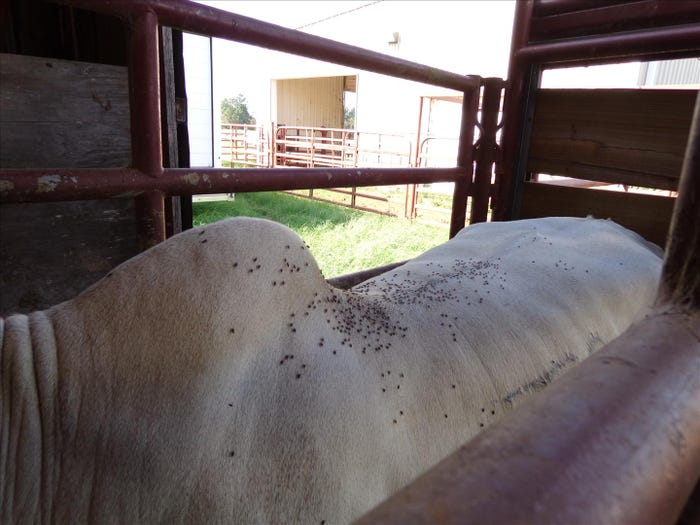Cattle producers should protect their animals as fly season accelerates, especially against horn and stable flies.
April 4, 2016

Springtime conditions bring increased fly activity, and cattle producers should take steps to protect animals and reduce losses, said Jason Banta, Texas A&M AgriLife Extension Service beef cattle specialist.
Horn flies, stable flies and house flies are the most common fly pests in Texas. Some may view flies as a nuisance to the animals, but flies also cost cattle producers hundreds of millions of dollars each year.
Banta said ranchers should be extra wary of horn and stable flies. The economic impact of the two species can cost a rancher more than $10 per calf in a 100-day period.

Horn flies gather on the back of a Brahman cow at the North Farm at the Texas AgriLife Extension and Research Center in Overton. Photo: Texas A
Those species, which feed on the blood of livestock, can stunt weight gain in suckling calves by 1 lb. every 10 days and in stocker calves and replacement heifers by 1 lb. every five days, Banta said. In a business where every pound counts, especially in today’s historically high market, ranchers should take steps to reduce fly breeding grounds or use treatment options to reduce pest populations, he said.
Avoiding those costs could be as easy as cleaning stables, maintaining pastures or using treatments such as insecticide ear tags and feed additives. Ranchers have to decide what options are most cost effective and best fit their management style when addressing fly problems, Banta said.
In Texas, Banta said horn flies are active now, and stable fly activity is being reported in some areas of the state.
Horn flies are the most detrimental to producers because they are active for a longer period of time throughout the year, he said. However, the species may be the easiest for producers to address because they only leave the cow to lay eggs in manure patties. Horn fly activity will peak in late spring, Banta said; numbers generally wane in the summer and peak again in the fall. He said ranchers should expect to see numbers increase over the next six weeks.
Horn flies, like all three of the species, can be identified most easily by their location on the animal. Horn flies typically swarm on the back of cattle or migrate to the sides and belly for shade and protection from the wind.
The historic cost threshold for horn flies is 200-250 flies per animal. “However, the price of cattle justifies treatments to lower (fly) numbers,” Banta said.
Producers have several options to treat horn flies. Banta said fly tags deliver insecticides over a longer period of time as the animal grooms and may last three to four months. Topical applications like pour-ons and sprays are also effective but don’t last as long, he said.
The product and method used are up to the rancher, as long as the insecticides contain effective active ingredients, Banta said. Producers should use products that include cyhalothrin, cyfluthrin and permethrin cypermethrin in pyrethroids and methoprene and diflubenzuron in insect growth regulators. Organophosphates should have phosmet, diazinon, coumaphos, tetrachlorvinphos, pirimiphos-methyl, dichlorvos or chlorpyrifos in them.
Flies build up a resistance to insecticides, so producers should also rotate the chemicals they use, Banta said. “Use the method that works for you, but rotate the chemical classes to fight resistance,” he said. “I recommend switching up every year.”
Producers can also utilize mineral supplements or molasses tubs with the active ingredient methoprene, Banta said. The minerals are consumed and treat manure patties to prevent eggs from hatching. Banta recommends year-round use of methoprene-containing mineral supplements or tubs for ranchers who incorporate those products already.
Stable flies pose the same threat to producers but are a different challenge to address. When ranchers see cattle bunching up together in a pasture during the spring, it’s a likely sign of stable flies, Banta said. The cattle try to work their way to the middle of the herd in an attempt to avoid the biting, blood-sucking fly. Stable flies typically gather on the animal’s legs, Banta said.
Banta said stable flies are most active around stables, pens and youth projects but have shown the ability to expand their environment.
In 2012, stable fly numbers in pasture environments increased significantly because piles of unconsumed, poor-quality hay were left in pastures, he said. Small piles of hay created perfect breeding grounds for stable flies when combined with moisture and manure.
Cleanliness goes a long way toward addressing stable flies, Banta said, whether it's regular cleaning of stables or spreading out piles of old hay in a pasture to allow it to dry.
“The best way to deal with stable flies is to manage possible breeding sites,” he said.
Insecticides or biological options, such as parasitic wasps, can be utilized to address stable flies because they are most prominent in concentrated areas, but treating stable flies with insecticides in an open pasture can be a challenge because the flies leave animals frequently and gather around the legs, Banta said.
Dimilin 2L, which can be used to combat young grasshoppers, is also effective against stable flies, Banta said. So, if producers need to spray for young grasshoppers, they can use Dimilin to help reduce stable fly numbers. Additionally, spot-spraying old hay sites with Dimilin can be effective, he said.
You May Also Like

.png?width=300&auto=webp&quality=80&disable=upscale)

